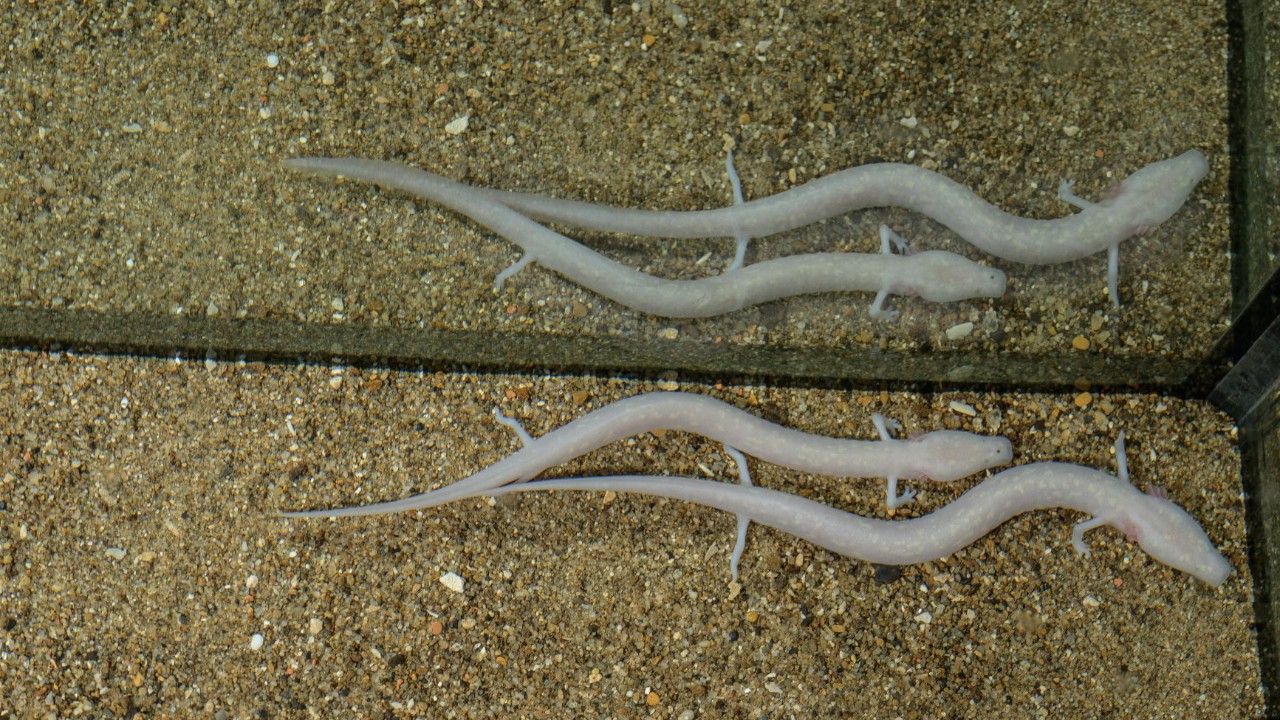Will Olms Provide Cures for Humans?
In collaboration with international experts, Slovenian scientists have decoded one of the largest known animal genomes.
The olm genome, which is 15 times larger than the human genome, is currently the world's largest decoded genome. The olm genome project is a project could contribute significantly to the development of diabetes treatment in the future, to better outcomes of regenerative medicine, as well as to understanding the causes of obesity, the aging process and longevity.
Marjan Batagelj, the Managing Director of Postojna Cave, and Katja Dolenc Batagelj, Executive Marketing Director and the head of Postojna Cave's underground laboratory, accepted an invitation to the keenly anticipated presentation of the decoded olm genome, which was held at the University of Ljubljana. Postojna Cave is an ardent supporter of the collaborative research project carried out by the University of Ljubljana, the Aarhus University in Denmark and the Chinese institute BGI Research. Postojna Cave also works with Dr Lilijana Bizjak Mali from the University of Ljubljana's Biotechnical Faculty in keeping a close watch on Postojna Cave's 21 olm juveniles in the cave laboratory, which has contributed to the olms being known all around the world.
This is just the beginning…
Although science has been researching olms for centuries (the very first olm was discovered right here, in Postojna cave, in 1797), they have remained one of science’s great mysteries. Scientists believe that the olm genome could make a significant contribution to the development of medicine. Special techniques have been used to sequence over a trillion nucleotides (the chemical letters specifying the information in the genome), and each nucleotide was read approximately 160 times. Dr Duncan Yu of the aforementioned BGI Research institute handed over the entire genome with an average of 160 reads to the University of Ljubljana’s rector, Igor Papič, in the form of a 7-terabyte large disk. According to Nina Gunde - Cimerman of the Biotechnical Faculty, the project leader and coordinator for Slovenia, the current genome sequence is a version that needs to be worked on further.
Presenting this remarkable achievement, the participants noted, "The olm or proteus (Proteus Anguinus) is an extraordinary animal, whose genome sequence is of great interest to the scientific community, because it holds promises for future discoveries regarding the olm's extraordinary evolution and adaptations to cave life. Furthermore, understanding its uncanny ability to regenerate lost or damaged parts of its body could pave the way for the innovation of new medical treatments of conditions requiring regenerative medicine and other human diseases, as well as new insights into aging and longevity."
Tiny genes that can change the world
"It has been proven that many a thing can be achieved by using the right approaches and communication. Through round-the-clock observation and sensibility, we have developed our underground laboratory to such an extent that we are able to report olm-related findings to science ourselves. Knowledge of the olms' genome, however, constitutes a higher level of understanding that can be invaluable to humanity," said Marjan Batagelj at the event. Therefore, Postojna Cave is happy to support and participate in any projects of this kind.
Dr Rok Kostanjšek from University of Ljubljana's Biotechnical Faculty emphasised that regrowing an amputated limb just as easily as olms is not really something humans can hope for, but merely understanding how these processes take place could contribute significantly to the development of regenerative medicine.
Scientists are currently most interested in the olms' longevity as related findings could pave the way for longer lives in humans. The ability to regrow lost or damaged limbs and organs – something we have recently witnessed in Postojna Cave – could for instance contribute to faster and more successful wound healing, as well as shorter post-surgery recovery. The olms can go without food for long periods of time without this causing any damage. They can also be overeat without any drastic consequences such as obesity and related diabetes. Understanding this could aid in the development of treatment for obesity, obesity-related diabetes and the effects of anorexia.
More knowledge
In the future, genome analysis could be used to determine the sex of individual olms, which is important for the existence of this endangered animal species, or to identify olm populations in the wild. The press conference also highlighted the need for protecting the environment and the clean waters inhabited by olms, which is something we point out on a regular basis in Postojna Cave, too.
For more on the project, see https://www.proteusgenome.com/
Last but not least, the remarkable news about olms was announced just a day after Postojna Cave's olms had starred in the BBC's long-awaited documentary Seven Worlds, One Planet: Europe. 😊


 slovenščina
slovenščina Deutsch
Deutsch italiano
italiano Hrvatski
Hrvatski français
français español
español polski
polski čeština
čeština magyar
magyar Русский
Русский Nederlands
Nederlands Português
Português 한국어 [韓國語]
한국어 [韓國語] 中国的
中国的 日本語
日本語 עברית
עברית

